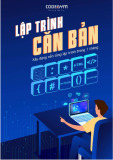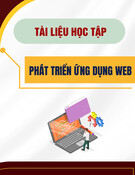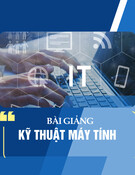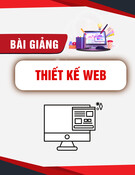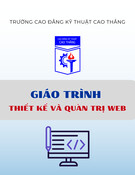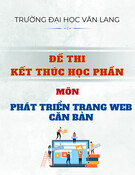1
1
Introduction to Computers, the Internet and the Web
2007 Pearson Education, Inc. All rights reserved.
2
The chief merit of language is clearness.
—Galen
Our life is frittered away by detail. …Simplify, simplify.
—Henry David Thoreau
He had a wonderful talent for packing thought close, and rendering it portable.
—Thomas B. Macaulay
2007 Pearson Education, Inc. All rights reserved.
3
Man is still the most extraordinary computer of all.
—John F. Kennedy
Things are always at their best in their beginning.
—Blaise Pascal.
2007 Pearson Education, Inc. All rights reserved.
4
OBJECTIVES
In this chapter you will learn: Basic computer concepts. The different types of programming languages. The history of the C programming language. The purpose of the C Standard Library. The elements of a typical C program development
environment.
Why it is appropriate to learn C in a first programming
course.
How C provides a foundation for further study of
programming languages in general and of C++, Java and C# in particular.
The history of the Internet and the World Wide Web.
2007 Pearson Education, Inc. All rights reserved.
5
1.1
Introduction
1.2 What Is a Computer?
1.3 Computer Organization
1.4 Early Operating Systems
1.5 Personal, Distributed and Client/Server Computing
1.6 Machine Languages, Assembly Languages and
High-Level Languages
1.7 Fortran, COBOL, Pascal and Ada
1.8 History of C
1.9 C Standard Library
2007 Pearson Education, Inc. All rights reserved.
6
1.10 C++
1.11 Java
1.12 BASIC, Visual Basic, Visual C++, Visual C# and .NET
1.13 Key Software Trend: Object Technology
1.14 Typical C Program Development Environment
1.15 Hardware Trends
1.16 History of the Internet
1.17 History of the World Wide Web
1.18 Notes About C and This Book
1.19 Web Resources
2007 Pearson Education, Inc. All rights reserved.
7
1.1 Introduction
We will learn
– The C programming language – Structured programming and proper programming
techniques
This book also covers C++
– Chapters 18-27 introduce the C++ programming language
This course is appropriate for
– Technically oriented people with little or no programming
experience
– Experienced programmers who want a deep and rigorous
treatment of the language
2007 Pearson Education, Inc. All rights reserved.
8
1.2 What is a Computer?
Computer
– Device capable of performing computations and making
logical decisions
– Computers process data under the control of sets of
instructions called computer programs
Hardware
– Various devices comprising a computer – Keyboard, screen, mouse, disks, memory, CD-ROM, and
processing units
Software
– Programs that run on a computer
2007 Pearson Education, Inc. All rights reserved.
9
1.3 Computer Organization Six logical units in every computer:
1. Input unit
- Obtains information from input devices (keyboard, mouse)
2. Output unit
- Outputs information (to screen, to printer, to control other
devices)
3. Memory unit
- Rapid access, low capacity, stores input information
4. Arithmetic and logic unit (ALU)
- Performs arithmetic calculations and logic decisions
5. Central processing unit (CPU)
- Supervises and coordinates the other sections of the
computer
6. Secondary storage unit
- Cheap, long-term, high-capacity storage - Stores inactive programs
2007 Pearson Education, Inc. All rights reserved.
10
1.4 Early Operating Systems
Batch processing
– Do only one job or task at a time
Operating systems
– Manage transitions between jobs – Increased throughput
- Amount of work computers process
Multitasking
– Computer resources are shared by many jobs or tasks
Timesharing
– Computer runs a small portion of one user’s job then moves on
to service the next user
2007 Pearson Education, Inc. All rights reserved.
11
1.5 Personal Computing, Distributed Computing, and Client/Server Computing
Personal computers
– Economical enough for individual
Distributed computing
– Computing distributed over networks
Client/server computing
– Sharing of information across computer networks between
file servers and clients (personal computers)
2007 Pearson Education, Inc. All rights reserved.
12
1.6 Machine Languages, Assembly Languages, and High-level Languages
Three types of programming languages
1. Machine languages
Strings of numbers giving machine specific instructions
- - Example:
+1300042774 +1400593419 +1200274027
2. Assembly languages
- English-like abbreviations representing elementary computer operations (translated via assemblers)
- Example:
LOAD BASEPAY ADD OVERPAY STORE GROSSPAY
2007 Pearson Education, Inc. All rights reserved.
13
1.6 Machine Languages, Assembly Languages, and High-level Languages
Three types of programming languages (continued)
3. High-level languages
- Codes similar to everyday English - Use mathematical notations (translated via
compilers) - Example:
grossPay = basePay + overTimePay
2007 Pearson Education, Inc. All rights reserved.
14
1.7 Fortran, COBOL, Pascal and Ada
Fortran
– developed by IBM Corporation in the 1950s – used for scientific and engineering applications that
require complex mathematical computations
COBOL
– developed
in 1959 by computer manufacturers, the
government and industrial computer users
– used for commercial applications that require precise and
efficient manipulation of large amounts of data
2007 Pearson Education, Inc. All rights reserved.
15
1.7 Fortran, COBOL, Pascal and Ada
Pascal
– Developed by Professor Niklaus Wirth in 1971 – Designed for teaching structured programming
Ada
– Developed under the sponsorship of the U.S. Department
of Defense (DOD) during the 1970s and early 1980s
– Able to perform multitasking
2007 Pearson Education, Inc. All rights reserved.
16
1.8 History of C
C
– Evolved by Ritchie from two previous programming languages,
BCPL and B
– Used to develop UNIX – Used to write modern operating systems – Hardware independent (portable) – By late 1970's C had evolved to "Traditional C"
Standardization
– Many slight variations of C existed, and were incompatible – Committee formed to create a "unambiguous, machine-
independent" definition
– Standard created in 1989, updated in 1999
2007 Pearson Education, Inc. All rights reserved.
17
Portability Tip 1.1
Because C is a hardware-independent, widely available language, applications written in C can run with little or no modifications on a wide range of different computer systems.
2007 Pearson Education, Inc. All rights reserved.
18
1.9 C Standard Library
C programs consist of pieces/modules called
functions
– A programmer can create his own functions
- Advantage: the programmer knows exactly how it works - Disadvantage: time consuming
– Programmers will often use the C library functions
- Use these as building blocks – Avoid re-inventing the wheel
- If a pre-made function exists, generally best to use it rather
than write your own
- Library functions carefully written, efficient, and portable
2007 Pearson Education, Inc. All rights reserved.
19
Performance Tip 1.1
Using Standard C library functions instead of writing your own comparable versions can improve program performance, because these functions are carefully written to perform efficiently.
2007 Pearson Education, Inc. All rights reserved.
20
Portability Tip 1.2
Using Standard C library functions instead of writing your own comparable versions can improve program portability, because these functions are used in virtually all Standard C implementations.
2007 Pearson Education, Inc. All rights reserved.
21
1.10 C++
C++
– Superset of C developed by Bjarne Stroustrup at Bell Labs – "Spruces up" C, and provides object-oriented capabilities – Dominant language in industry and academia
Learning C++
– Because C++ includes C, some feel it is best to master C,
then learn C++
– Starting in Chapter 18, we begin our introduction to C++
2007 Pearson Education, Inc. All rights reserved.
22
1.11 Java
Java is used to
– Create Web pages with dynamic and interactive content – Develop large-scale enterprise applications – Enhance the functionality of Web servers – Provide applications for consumer devices (such as cell
phones, pagers and personal digital assistants)
Java How to Program
– Closely followed the development of Java by Sun – Teaches first-year programming students the essentials of
graphics, images, animation, audio, video, database, networking, multithreading and collaborative computing
2007 Pearson Education, Inc. All rights reserved.
23
1.12 BASIC, Visual Basic, Visual C++, Visual C# and .NET
BASIC
– Developed in the mid-1960s by Professors John Kemeny and Thomas Kurtz of Dartmouth College as a language for writing simple programs
Visual Basic
– Introduced by Microsoft in 1991 to simplify the process of
making Windows applications
Visual Basic, Visual C++, and Visual C#
– Designed for Microsoft’s .NET programming platform
2007 Pearson Education, Inc. All rights reserved.
24
1.13 Key Software Trend: Object Technology
Objects
– Reusable software components that model items in the real
world
– Meaningful software units
- Date objects, time objects, paycheck objects, invoice objects, audio objects, video objects, file objects, record objects, etc.
- Any noun can be represented as an object
– Very reusable – More understandable, better organized, and easier to
maintain than procedural programming
– Favor modularity
2007 Pearson Education, Inc. All rights reserved.
25
1.14 Typical C Program Development Environment
Phases of C++ Programs:
–Edit –Preprocess –Compile –Link –Load –Execute
Fig. 1.1 | Typical C development environment.
2007 Pearson Education, Inc. All rights reserved.
26
Common Programming Error 1.1
Errors like division-by-zero occur as a program runs, so these errors are called runtime errors or execution-time errors. Divide-by-zero is generally a fatal error, i.e., an error that causes the program to terminate immediately without successfully performing its job. Nonfatal errors allow programs to run to completion, often producing incorrect results. [Note: On some systems, divide-by-zero is not a fatal error. Please see your system documentation.]
2007 Pearson Education, Inc. All rights reserved.
27
1.15 Hardware Trends
Every year or two the following approximately
double:
– Amount of memory in which to execute programs – Amount of secondary storage (such as disk storage) - Used to hold programs and data over the longer term
– Processor speeds
- The speeds at which computers execute their programs
2007 Pearson Education, Inc. All rights reserved.
28
1.16 History of the Internet: IOT
The Internet enables
– Quick and easy communication via e-mail – International networking of computers
Packet switching
– The transfer of digital data via small packets – Allows multiple users to send and receive data simultaneously
No centralized control
– If one part of the Internet fails, other parts can still operate
TCP/IP Bandwidth
– Information carrying capacity of communications lines
2007 Pearson Education, Inc. All rights reserved.
29
1.17 History of the World Wide Web
World Wide Web
– Locate and view multimedia-based documents on almost
any subject
– Makes information instantly and conveniently accessible
worldwide
– Possible for individuals and small businesses to get
worldwide exposure
– Changing the way business is done
2007 Pearson Education, Inc. All rights reserved.
30
1.18 General Notes About C and This Book
Program clarity
– Programs that are convoluted are difficult to read,
understand, and modify
C is a portable language
– Programs can run on many different computers – However, portability is an elusive goal We will do a careful walkthrough of C – Some details and subtleties are not covered – If you need additional technical details
- Read the C standard document - Read the book by Kernigan and Ritchie
2007 Pearson Education, Inc. All rights reserved.
31
Good Programming Practice 1.1
Write your C programs in a simple and straightforward manner. This is sometimes referred to as KIS (“keep it simple”). Do not “stretch” the language by trying bizarre usages.
2007 Pearson Education, Inc. All rights reserved.
32
Portability Tip 1.3
Although it is possible to write portable programs, there are many problems between different C compilers and different computers that make portability difficult to achieve. Simply writing programs in C does not guarantee portability. The progammer will often need to deal directly with complex computer variations.
2007 Pearson Education, Inc. All rights reserved.
33
Software Engineering Observation 1.1
Read the manuals for the version of C you are using. Reference these manuals frequently to be sure you are aware of the rich collection of C features and that you are using these features correctly.
2007 Pearson Education, Inc. All rights reserved.
34
Software Engineering Observation 1.2
Your computer and compiler are good teachers. If you are not sure how a feature of C works, write a sample program with that feature, compile and run the program and see what happens.
2007 Pearson Education, Inc. All rights reserved.

![Câu hỏi ôn tập An toàn mạng môn học: Tổng hợp [mới nhất]](https://cdn.tailieu.vn/images/document/thumbnail/2025/20250919/kimphuong1001/135x160/30511758269273.jpg)
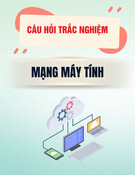
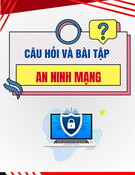




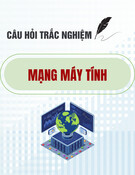
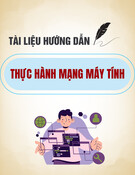
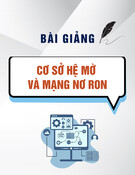
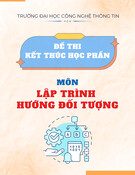
![Câu hỏi trắc nghiệm Lập trình C [mới nhất]](https://cdn.tailieu.vn/images/document/thumbnail/2025/20251012/quangle7706@gmail.com/135x160/91191760326106.jpg)
